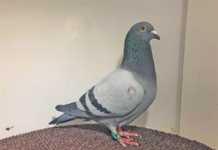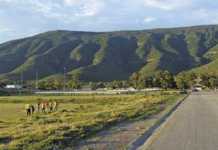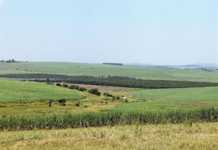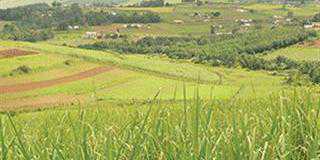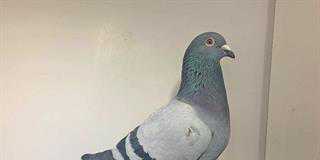
“Culture and nature have co-evolved over time to become mutually dependent. We lose one, we lose the other,” says Tony Dold, plant taxonomist, ethnobotanist and curator of the Selmar Schonland Herbarium at the Albany Museum in Grahamstown, about the central theme of his new book Voices from the Forest. The book, co-authored with his wife Dr Michelle Cocks, “demonstrates how plants and nature have for many years influenced a certain group of people – the Xhosa – and their culture, traditions and religion,” he explains.
Dr Cocks, who is a research officer at the Institute for Social and Economic Research at Rhodes University, adds that their book is aimed at stimulating debate about the role indigenous knowledge plays in creating Xhosa identity. “We think it’s extremely important that indigenous knowledge receives greater acknowledgement,” she says. “We’re hoping that Voices from the Forest will help to provide a platform for discussions.”

Dr Michelle Cocks and Tony Dold. Photos courtesy of Tony Dold
The xhosa links with the forest
In their research, which took 10 years, the authors interviewed numerous rural Xhosa and Mfengu people, and the words of just one, Bhuti Mzwabantu, sum up the rich bio-cultural heritage that is part of their identity. “We like the forest because it gives us everything we need. We get medicine, fuel-wood and food from the forest. We visit it because this is where the ancestors are and we must talk to them from time to time,” he says.
One only has to look at Xhosa uses for trees from vegetation types such as the unique Albany Thicket (see box) and Afromontane forests in and around the former Ciskei to appreciate fully this intricate relationship. When leaving home, Xhosa men carry sticks cut from the wild olive tree (umnquma), while young men fresh from completing the circumcision rite carry staffs from the kooboo-berry (umnqayi tree) and in certain instances the star-apple (umbongisa).
Traditional praise poets, on the other hand, gesticulate with umsimbithi sticks (from the umzimbeet tree), while novice diviners carry small staffs taken from the plumbago tree (umatshinitshini). These seers use a wide range of plants, including unozitholana (dream root) to facilitate communication with the ancestors. Xhosa cattle byres – in which all sacrificial slaughtering is done – are often built from wood such as the sweet thorn (umnga), while tethering poles are usually cut from the wild olive and sneezewood (umthathi).
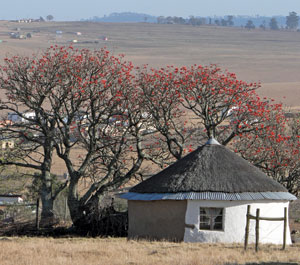
Coral trees towering over Xhosa homes in the Eastern Cape.
The sacrificial meat (intsonyama) is charred using wood from the sneezewood tree and served on the leaves of the wild olive, which produces a bitter taste believed to invoke the attention of the ancestors. According to Dold, this relationship with nature is directly linked to a Xhosa dedication to their ancestors. “Xhosa culture is strong because the religion is strong,” he explains.
“Most Xhosa people I know still have a connection somewhere in a rural area to which they return once every year or two where the culture is nurtured.” He adds that in certain areas of the former Ciskei, increased wealth has fuelled traditional cultural practices. ”In places, you’ll find cultural practices being performed a lot more and they’re much bigger, ” he explains. “It has now become almost fashionable to indulge in traditional cultural practices and it’s also an expression of status.”
Managing the trade
Perhaps most telling of the relationship between Xhosas and plants is the vibrant trade in more than 200 species of medicinal plants. These can be divided into two broad groups: amayeza okuzinyanga (therapeutic medicines) and amayeza okwenza amasiko (medicines for customs and rituals).
A huge network of gatherers and middlemen/women supply traditional healers and Xhosa chemists (ikhemestis) with plant material and animal parts, while most of these outlets also specialise in indigenised over-the-counter products. Parallel with these are street-based medicinal plant traders – predominantly middle-aged women – who contribute to an informal traditional medicine industry estimated to serve 27 million customers and to be worth R2,9 billion annually.
It involves more than 700 species of plants, many of which are declining rapidly in the wild.

The Cape beech is among one of the 10 most commonly sold medicinal plants in the Eastern Cape. Numbers are declining due to medicinal bark harvesting.
“All plants are harvested from the wild and popular plants are becoming extinct locally and being sold for very high prices,” says Dold. “It’s all about supply and demand, and there’s a lot of plant material moving through (informal channels).” Of particular concern to him are the Eastern Cape street traders, who harvest huge amounts of plant material but also waste a large percentage.
He says that according to the Eastern Cape Department of Water Affairs and Forestry (DWAF) such trade in plant material is simply illegal and should be dealt with accordingly. But he stresses the need for co-operation with these traders, including supplying them with storage facilities to minimise wastage.
“If you ban the trade it will just go underground,” he warns. “We need to work with these people and get some kind of understanding of what’s happening.” Meanwhile, the future looks bleak for certain plants, including the Cape onionwood (ummemezi), the bark of which is a sought after skin lightener. This is especially the case in the Pirie Forest of the Amathole Mountains near King William’s Town.
“We did a botanical and social survey and our conclusion is that it’s on its way out,” he says. “There are no big trees producing fruits. There are only tiny trees left and even those are being debarked. At R200/kg, it is ‘gold’.”
Preserving biodiversity
This harvesting of wild plants is simply unsustainable, according to Dold. He adds, however, that the situation offers an opportunity for Xhosa growers to supply the market with home-cultivated medicinal plants. Already, individuals in certain areas of the Ciskei are cultivating plants such as unozitholana (dream root) in their homestead gardens. Challenges remain, however. For example, Xhosa people are unwilling to grow Cape onionwood because it is believed to attract lightning.

Medicinal plant traders in King William’s Town supply a large variety of plant material to increasingly urbanised Xhosa communities. Tony Dold
“They don’t want it anywhere near their homes,” says Dold. “In fact, women who have it on their faces will wash it off if they see a storm approaching.” Although he is adamant the cultivation of medicinal plants could help to alleviate harvesting pressure in the wild, he does not believe in establishing community-driven nurseries. “These don’t work because there’s no ownership. Somebody has to drive it and our thinking is that it has to be an entrepreneur,” he stresses.
As part of its drive to build awareness of the fragility of the ecosystem and the link between people and nature, the Selmar Schonland Herbarium has facilitated the Inkcubeko Nendalo Biocultural Diversity Education Programme. Endorsed by the Eastern Cape Department of Education, the programme is currently operational in seven Grahamstown schools and includes weekly field trips. “It’s crucial for people to establish a relationship with nature,” says Dr Cocks. “Only when this is done, will they respect nature and appreciate its true value.”
Imifino and exotic medicinal plants
The Xhosa women above are cooking imifino (pot herbs), a popular and healthy dish. As many as 200 imifino plants are used by the Xhosa, of which a significant proportion originate from other parts of the world and are today regarded as weeds in South Africa. For example, by 1772, the Swedish traveller Carl Thunberg recorded that ihlaba (cow thistle) and umsobosobo (black nightshade) was being used in the Cape Colony.
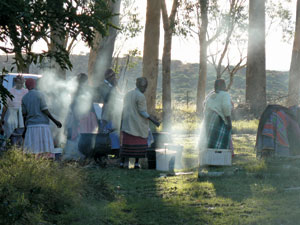
Over the years, several exotic medicinal plants have also been absorbed into Xhosa traditions. These include the pomegranate, nightshade and castor oil plant. According to Tony Dold, even the popular air plant, which originates from the Americas, has been invested with supernatural power: it is used in parts of the former Ciskei as a talisman to protect homes from evil forces.
War charms from Mlanjeni to Marikana
Plants always played a crucial role when the Xhosa were at war. During the 8th Frontier War (1850 to 1853), the war prophet Mlanjeni ordered warriors to rub themselves with the juices of the roots from the ikhubalo likaMlanjeni (powdered-leafed pelargonium) to ensure invincibility in the face of the enemy’s bullets. Warriors were also told to chew on sticks of umthi kaMlanjeni (plumbago), and call on the blessings of the ancestors while spitting the fibres out.
Although the war was lost by Mlanjeni’s warriors, the plants he ordered the warriors to use in the mid-1800s are to this day named after him. It is interesting to note that according to various reports, the Lonmin miners involved in the Marikana shooting in August of this year, a large number of whom were from the Eastern Cape, prepared themselves to face the police and their modern weapons by smearing muti onto their bodies.
The Xhosa and Mfengu people
The Mfengu people originated from modern-day KwaZulu-Natal and arrived in the Eastern Cape as a consequence of the mainly Zulu-fuelled Mfecane (’scattering’) – a period of wars and upheaval in the 18th and 19th centuries. They first lived among the Gcaleka Xhosa near the Kei River, but in the 1830s rebelled and swore allegiance to the British Crown, settling near the Keiskamma River in what would later become the Ciskei.
The colonial powers established the Mfengu as a buffer between white settlers and the Xhosa. Nonetheless, the Mfengu today practise Xhosa customs, although differences exist. Surnames that originated in KZN rather than the Eastern Cape are pronounced differently, Mfengu women stack their wood vertically rather than parallel to the ground, and people of Mfengu descent prefer square cattle byres to the traditional circular Xhosa types.
The Albany Thicket biome
Albany Thicket, shown below near the Great Fish River, dominates large parts of the former Ciskei. Believed to be more than 50 million years old, it comprises woody, thorny, semi-succulent plants averaging 2m to 3m in height, and has greater floral biodiversity – 6 500 plant species – than any other vegetation biome in the country. This variety helps to sustain a broad range of animal species: 48 large mammals, 25 ungulates, 420 birds and a host of reptiles.
Contact Tony Dold at [email protected]
Contact Dr Michelle Cocks at [email protected]

